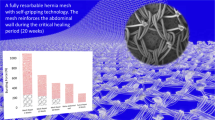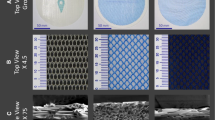Abstract
Introduction
From its introduction in 2000 until its US recall in December 2005, the Composix Kugel mesh was implanted in an estimated 350,000 patients worldwide. In our patients, minor postoperative complications were followed after a few years by more serious problems (persistent abdominal pain, infections, intestinal perforations). In this study, we take stock after a 5-year follow-up and issue a plea for improved product development strategies and the creation of hernia registries.
Patients and methods
Between 2003 and 2006, we implanted the Bard® Composix® Kugel® mesh in 21 patients (11 men, 10 women, mean age 63.2 ± 13.7 years) with incisional hernias using the open intraperitoneal onlay mesh technique. The mesh is made on one side of ePTFE and on the other of polypropylene and is expanded by a polyethylene (PET) memory recoil ring. The average follow-up was 45.5 months. All patients had at least one risk factor for hernia recurrence. Explanted prostheses were analyzed by scanning electron microscopy (SEM) and subjected to mechanical strength tests.
Results
During the postoperative course, six patients suffered a wound healing disorder. Ten patients complained of persistent abdominal wall pain and four experienced recurrence of the hernia. In one patient, the mesh had to be explanted due to chronic infection. In one patient, the PET memory recoil ring broke after 5 years of follow-up with consequent small bowel perforation. The PET memory recoil ring exhibited clear signs of degradation on SEM and unmistakable signs of material fatigue in a materials testing machine.
Conclusions
Patients with recalled Composix Kugel meshes face a singular risk for complications that may occur even many years after implantation. The most serious complication is the breakage of its PET memory recoil ring. Since the recall of the Composix Kugel Mesh, we have discontinued its use. It is necessary that future complications are documented in a common post-market surveillance registry. Algorithms need to be developed and promoted to support affected patients and surgeons.





Similar content being viewed by others
References
Dietz UA, Hamelmann W, Winkler MS, Debus ES, Malafaia O, Czeczko NG, Thiede A, Kuhfuß I (2007) An alternative classification of incisional hernias enlisting morphology, body type and risk factors in the assessment of prognosis and tailoring of surgical technique. J Plast Reconstr Aesthet Surg 60(4):383–388
Dietz UA, Kuhfuss I, Debus ES et al (2006) Mario Donati and the vertical mattress suture of the skin. World J Surg 30:141–148
Bringman S, Conze J, Cuccurullo D, Deprest J, Junge K, Klosterhalfen B, Parra-Davila E, Ramshaw B, Schumpelick V (2010) Hernia repair: the search for ideal meshes. Hernia 14(1):81–87
Hope WW, Iannitti DA (2009) An algorithm for managing patients who have Composix Kugel ventral hernia mesh. Hernia 13(5):475–479
Cobb WS, Harris JB, Lokey JS, McGill ES, Klove KL (2003) Incisional herniorrhaphy with intraperitoneal composite mesh: a report of 95 cases. Am Surg 69(9):784–787
Cobb WS, Carbonell AM, Kalbaugh CL, Jones Y, Lokey JS (2009) Infection risk of open placement of intraperitoneal composite mesh. Am Surg 75(9):762–767
Furukawa K, Taniai N, Suzuki H, Kiyama T, Nomura T, Takahashi T, Yoshiyuki T, Tajiri T (2005) Abdominal incisional hernia repair using the Composix Kugel patch: two case reports. J Nihon Med Sch 72(3):182–186
Iannitti DA, Hope WW, Norton HJ, Lincourt AE, Millikan K, Fenoglio ME, Moskowitz M (2008) Technique and outcomes of abdominal incisional hernia repair using a synthetic composite mesh: a report of 455 cases. J Am Coll Surg 206(1):83–88
Dietz UA, Winkler MS, Härtel RW, Fleischhacker A, Wiegering A, Isbert C, Jurowich C, Heuschmann P, Germer CT (2012) Importance of recurrence rating, morphology, hernial gap size, and risk factors in ventral and incisional hernia classification. Hernia (Epub ahead of print)
Klinge U (2008) Mesh for hernia repair. Br J Surg 95:539–540
Liu FD, Li JY (2011) Surgical repair of the abdominal bulge using Composix Kugel patch with the intraperitoneal onlay mesh technique. Plast Reconstr Surg 128(2):103e–104e
Tsereteli Z, Ramshaw B, Ramaswamy A (2008) Chronic posterior seroma with neoperitoneum following laparoscopic ventral hernia repair: treatment algorithm. Hernia 12(4):363–366
Robinson TN, Clarke JH, Schoen J, Walsh MD (2005) Major mesh-related complications following hernia repair: events reported to the Food and Drug Administration. Surg Endosc 19(12):1556–1560
Greenberg JJ (2010) Can infected composite mesh be salvaged? Hernia 14(6):589–592
Dietz UA, Spor L, Germer CT (2011) Management of mesh related infections. Chirurg 82:208–217
Hayami S, Hotta T, Takifuji K, Iwahashi M, Mitani Y, Yamaue H (2009) Reconstruction of an infected recurrent ventral hernia after a mesh repair using a pedicled tensor fascia lata flap: report of two cases. Surg Today 39(9):811–817
Chelala E, Debardemaeker Y, Elias B, Charara F, Dessily M, Allé JL (2010) Eighty-five redo surgeries after 733 laparoscopic treatments for ventral and incisional hernia: adhesion and recurrence analysis. Hernia 14(2):123–129
LeBlanc KA, Whitaker JM (2002) Management of chronic postoperative pain following incisional hernia repair with Composix mesh: a report of two cases. Hernia 6(4):194–197
Muysoms FE, Bontinck J, Pletinckx P (2011) Complications of mesh devices for intraperitoneal umbilical hernia repair: a word of caution. Hernia 15(4):463–468
Berrevoet F, Van den Bossche B, de Baerdemaeker L, de Hemptinne B (2010) Laparoscopic evaluation shows deficiencies in memory ring deployment during small ventral hernia repair. World J Surg 34(7):1710–1715
Cozad MJ, Grant DA, Bachman SL, Grant DN, Ramshaw BJ, Grant SA (2010) Materials characterization of explanted polypropylene, polyethylene terephthalate, and expanded polytetrafluoroethylene composites: spectral and thermal analysis. J Biomed Mater Res B Appl Biomater 94(2):455–462
Costello CR, Bachman SL, Grant SA, Cleveland DS, Loy TS, Ramshaw BJ (2007) Characterization of heavyweight and lightweight polypropylene prosthetic mesh explants from a single patient. Surg Innov 14(3):168–176
O’Dowd A (2012) UK launches inquiry into safety of PIP breast implants. BMJ 3(344):e11
Muysoms F, Campanelli G, Champault GG, DeBeaux AC, Dietz UA, Jeekel J, Klinge U, Köckerling F, Mandala V, Montgomery A, Morales Conde S, Puppe F, Simmermacher RK, Śmietański M, Miserez M (2012) EuraHS: the development of an international online platform for registration and outcome measurement of ventral abdominal wall hernia repair. Hernia 16(3):239–250
Conflict of interest
AW, NS, AT, CI, CJ, SD and CG declare no conflict of interest. UD makes known that he has or has had business relationships with the following companies: B.Braun-Aesculap, Covidien and Ethicon. Activities in connection with these companies include consulting, speaking, advising and research; UD declares no conflict of interest that directly relates to this study.
Author information
Authors and Affiliations
Corresponding author
Rights and permissions
About this article
Cite this article
Wiegering, A., Schlegel, N., Isbert, C. et al. Lessons and challenges during a 5-year follow-up of 21 Composix Kugel implantations. Hernia 17, 435–443 (2013). https://doi.org/10.1007/s10029-013-1096-5
Received:
Accepted:
Published:
Issue Date:
DOI: https://doi.org/10.1007/s10029-013-1096-5




